AI Character Analysis Enriching Character Development
Posted: April 2, 2018 | Updated: March 24, 2023
Posted In: Articles
Each StoryFit Content Insights Report delivers specific insights to the most important elements of the story: In this series we’ll give some examples of real movie and television scripts that StoryFit’s Artificial Intelligence analyzed and what it reveals.
StoryFit Content Insights: Character Analysis
Now that we’ve covered what the StoryFit Content Insights Overview shows, let’s talk character analysis. Here we’ll dive into all of the things you can learn from the character section of the StoryFit Content Insight Reports.
StoryFit uses natural language processing (NLP) and machine learning to analyze character development by automatically measuring the entire story and creating an automated character study.
Studios and entertainment professionals use this section in development, casting, and marketing–specifically to inform targeted marketing and early testing of cast and collateral branding.
Why does this matter?
Simply put, knowledge is power, and may mean more profitable or more well-received stories.
Example questions our story AI can answer:
- How big is the cast? Can some characters be combined?
- Are the characters likable? Is there a clear villain? A clear hero?
- Is there a good love story or friendship running throughout?
Each Content Insights Report divides the character analysis into three sections: the Character Network, Character Scores, and the Major Character Breakdown.
Section 1: Overview – Character Network
The Character Network is a visual map of a script’s main characters’ interactions and centrality to the overall story. From the Character Network, we can visualize and quantify:
- Counts of major characters (we count major characters as any with 10% or more of dialogue as marked in the script), supporting characters (between 4% and 9% of dialogue), and minor characters (3% or less of dialogue) — What is the breakdown of the cast? Which characters drive the narrative?
- Centrality, which measures the percentage of shared interactions — Which characters and relationships are at the heart of the story?
- Percentage of scenes a character appears in — They talk a lot, but are they in a lot of scenes?
- Characters that interact most — Who is the story pairing together? Is this a buddy comedy? Mother-daughter drama? Love story? Revenge story?
For example, here is the character network for Everything Everywhere All at Once:
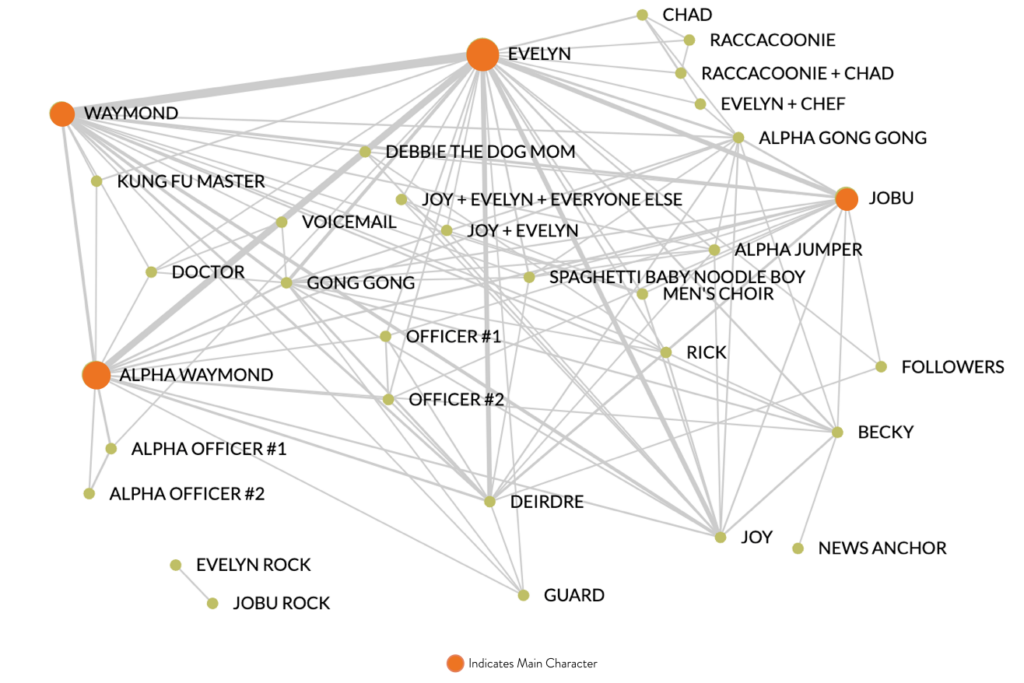
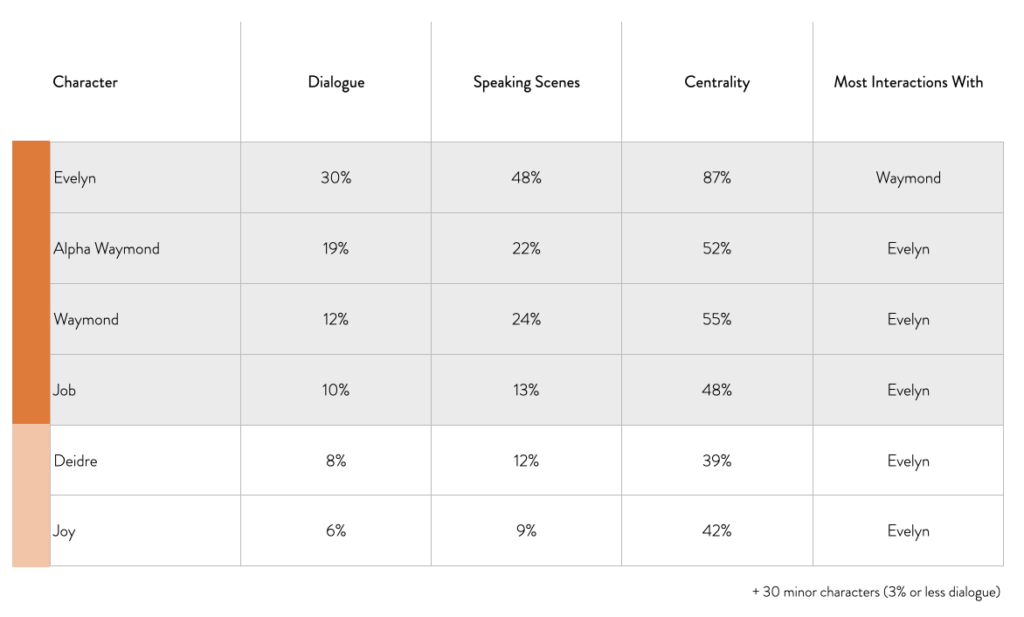
We can see that although Everything Everyone All at Once boasts a sprawling and interconnected narrative, family dynamics are at the heart of the narrative.
Evelyn is the protagonist at the center of the story, and her emotionally intense relationships with her husband Waymond and daughter Jobu propel the narrative action.
Now compare EEAAO’s character network with Tár’s:

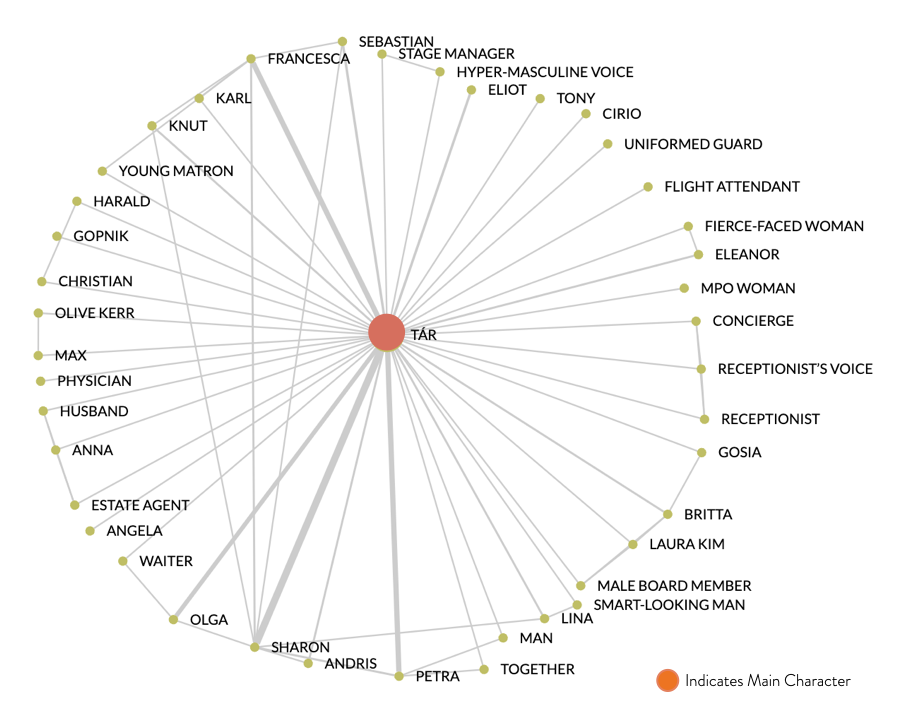
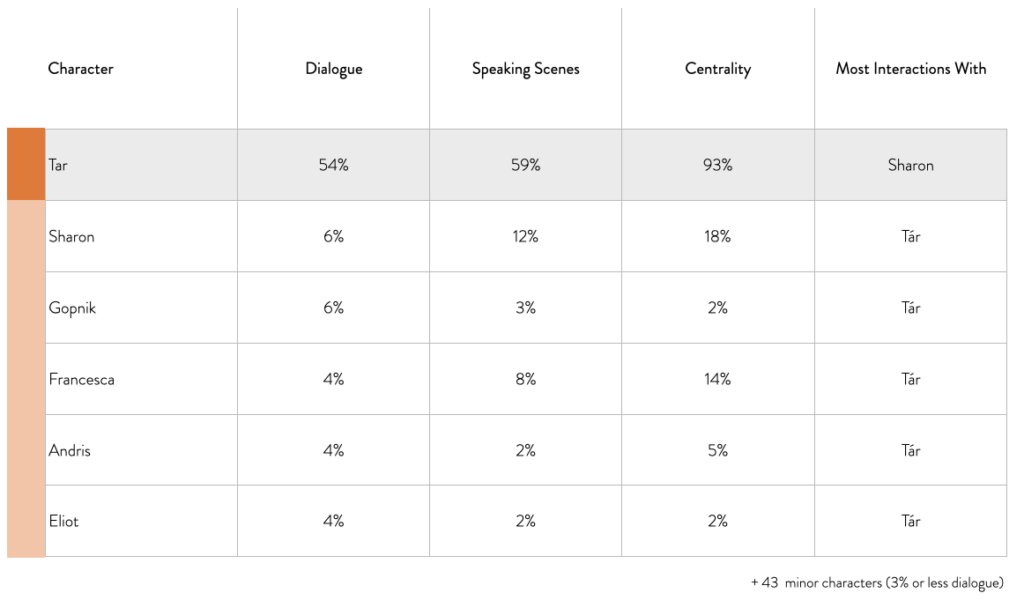
Tár’s character network, which is shaped like a near-perfect wagon wheel revolving around Lydia Tár, illustrates the film’s tight focus on Tár’s perspective.
Few secondary characters used in the film interact with each other without Tár’s involvement, leading the audience to stay trapped within her headspace. Tár is a character study!
Section 2: Character Scores
The Character Score is a character analysis tool that helps us evaluate the strength of a script’s major characters.
This score is an overall indicator of a character’s potential, as it measures the defining character traits the audience will recognize. Strong characters are the foundation of good stories. A higher score is always better, as this character assessment correlates to the success of a series or film.
Let’s take a look at the Character Score for a breakout television character, Breaking Bad’s Walter White, as he is one of a few engaging examples of a Gold Standard character.
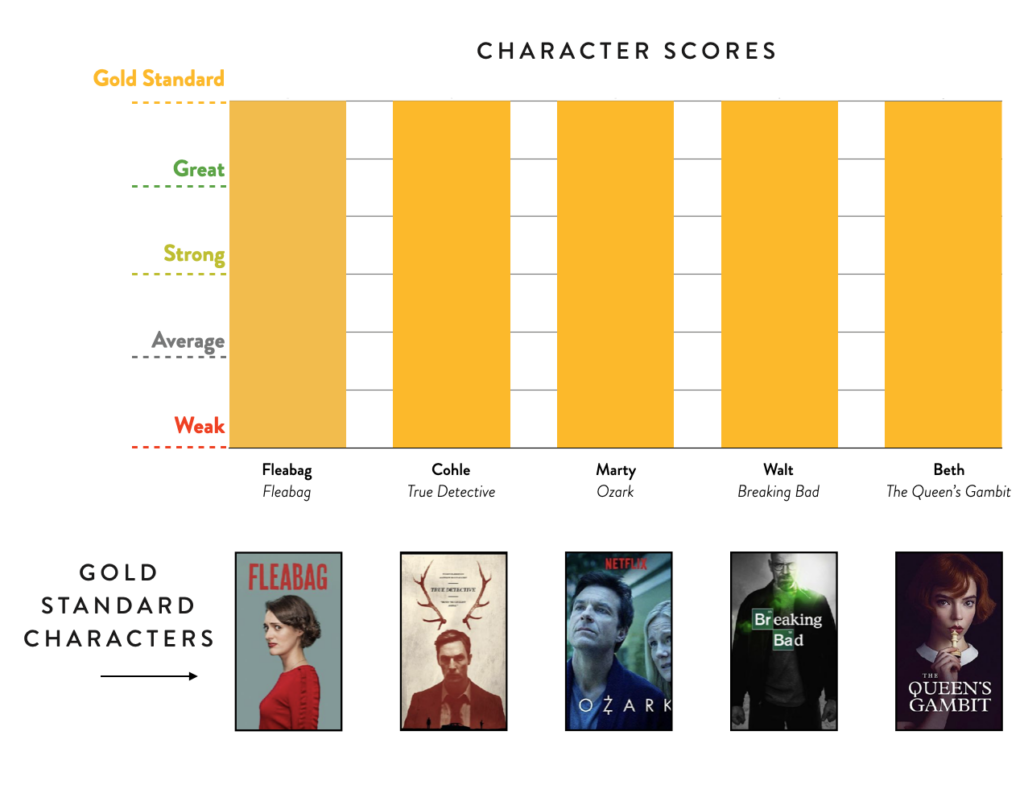
Walter meets the Gold Standard!
He has a well developed personality, and audiences will easily recognize his standout personality traits such as arrogance, which he expresses through disdain for his job and students, and creativity, which he demonstrates when he synthesizes a gas on the spot that knocks out his enemies. These strong traits help the audience create a relationship with Walter and maximize their engagement with the narrative.
Section 3: Major Character Breakdown
Characters are fictionalized people. Because of this, we use the lens of psychology and social science to understand how characters think, feel, behave, and interact with their story worlds.
Using NLP, we are able to perform dialogue and sentiment analysis.
We look at what major characters talk about and what they do, and deliver a detailed analysis of:
- Their Motives — what drives this character to act? How do they think?
- Their Behavior — how does this character interact with their story world?
- Audience Perception — how will an audience respond to this character?
Using this psychological framework, we can answer questions such as:
- Who is this character?
- How do they operate as drivers of plot?
- Are they interesting enough to stand on their own, or should they be combined with another character?
Being able to answer these questions is fundamental to audience comprehension and enjoyment of narratives.
When Motives and Behavioral character traits are clearly represented (which we measure using our models), the audience can more easily discern how and why character decisions are meaningful in the larger context of the narrative. This maximizes the likelihood of audience engagement because it means they can follow the story.
Let’s break down each component of our psychological framework!
Motives
A character’s motivation refers to what drives them to act.
Much has been written about how strong narratives typically include some inciting incident to drive the plot, but the inciting incident must interact with a certain character trait to push the story forward. This interaction is what puts characters at the heart of a story.
Here are a few examples of Motive traits that StoryFit’s narrative analysis software identifies:
- loves family
- arrogant
- innovative
- anxious
To put Motive traits into context, let’s return to the example of Walter White from Breaking Bad. Walter’s cancer diagnosis (the inciting incident) would not have motivated him to start cooking meth if he did not have an innovative mindset and a strong love for his family.
Behavior
Behavior traits capture how a character interacts with other characters and the story world around them.
Here are a few examples of Behavior traits that we measure using NLP:
- Organized
- Leader
- Obedient
- Crude
There is no one-to-one relationship between any Motive trait and Behavior trait. A character who is anxious may be driven to behave in an organized fashion, or they may be driven to be obedient.
What is important about making these connections is that the audience can learn who a character is and how they operate as drivers of the plot.
Audience Perception
Using machine learning, we simulate how an audience will respond to films and television Audience Perception traits predict an audience’s judgment of the main character.
Here are a few examples of Audience Perception traits:
- Heroic
- Likable
- Thought Provoking
Now let’s apply these character analysis techniques to Walter White!
Distinct Motives and Behavioral traits drive strong Audience Perception scores for Walter.
Viewers can track how Walter’s boldness and love for his family motivate him to disrespect authority and get into the meth-making business, where he succeeds due to his methodical and skilled approach.
Because the audience understands the relatable motives that drive Walt’s illegal and harmful behavior, they will perceive him as interesting and multi-dimensional.
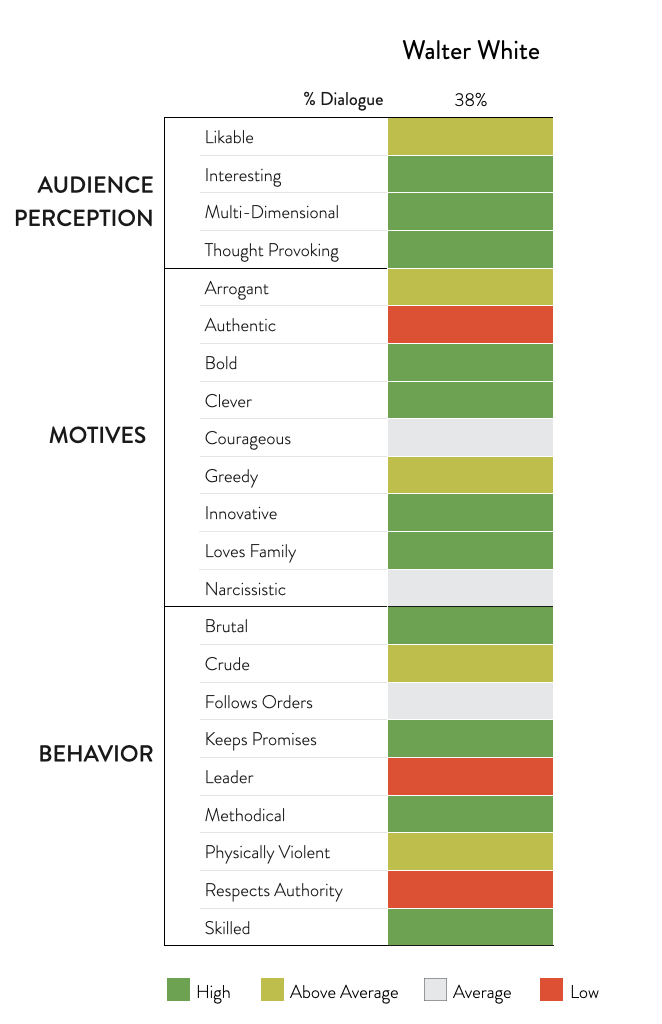
In conclusion
Characters have a strong and measurable influence in the ultimate success or failure of a film or series. StoryFit holds a mirror to major characters and minor characters, delivering great detail on their role in the story and their ultimate impact.
From the script alone, StoryFit delivers a detailed character analysis and answers questions such as: Is this a dynamic role that any actor will want to sink their teeth into? Or are the character’s traits un-engaging and lacking an overall character arc? What is the character’s relationship with other characters?
Writers could spend months trying to write a character analysis with as much detail, and the benefit here is the additional comparison data on thousands of character profiles. Creative teams can draw conclusions from data built to support creative work. This data supports their vision and can be used to enrich characters critical to the story.
Please reachout to StoryFit directly to work with us on your next project.
